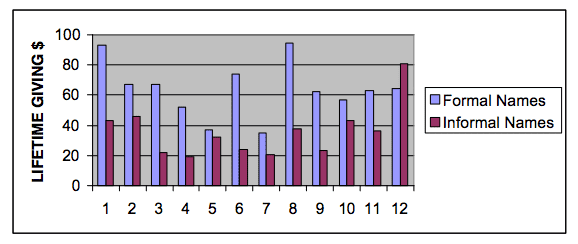It's a shame about Ray
Data Mining for Fund Raisers by Peter B. Wylie is one of the best introductory guides to the effective use of data that you'll get your hands on.
It's pretty hard to track down in the UK, but you can get it from CASE in the USA.
But luckily for us, Peter has also published a number of papers that you can find quite easily on SupportingAdvancement.com (scroll to the bottom of the list).
Once there, you'll find one particular study that helps demonstrate something rather interesting about data use.
It compares giving behaviour with the length of a donor's name. The file in question was predominantly male. Analysis showed that a number of donors were recorded with either an informal of formal first name…
- William or Bill
- Robert or Bob
- Richard or Dick
- Edward or Ed
- Kenneth or Ken
- Michael or Mike
- Ronald or Ron
- Thomas or Tom
- Donald or Don
- John or Jack
- James or Jim
- Raymond or Ray
Lifetime giving analysis showed that in 11 out of the 12 pairs, donors with formal names had given considerably more than those with informal names (Raymond/Ray was the only exception).

The probability of this having occurred by chance is less than one in four thousand. So what does it mean?
After some more digging, the analyst found evidence of a link between the amount of information held about a donor and their propensity to give. In short, more information equals more money.
It's almost a no-brainer. Virtually all Bluefrog's data propensity models take this into account when predicting the likelihood of someone leaving a legacy or upgrading a committed gift.
So what's the point of highlighting this finding?
Its very nature tells us something that is going to be of growing significance for fundraisers.
Non-financial data can be used to enhance financial data when modelling future giving behaviour.
And with the growth in the number of ways donors can interact with charities, we need to start paying more attention to the huge amount of non-financial information we have and how we collect it (obviously with permission).
And to start you off, perhaps you should take a look at your supporters who make comments on your website. You might be pleasantly surprised by just how lovely these people are when added to an appropriate communication programme.
Tags In
Related Posts
1 Comment
Comments are closed.
The Essentials

Crack the Code to Regular Giving: Insights, Strategies, and a Special Giveaway!

‘Tis Halloween. Keep to the light and beware the Four Fundraisers of the Apocalypse!

Why do people give? The Donor Participation Project with Louis Diez.

A guide to fundraising on the back of a postcard

What does the latest research tell us about the state of fundraising?






Fascinating! More info certainly equals more money — that makes complete sense. What I find counter-intuitive is that I’d think donor files with a donor’s “nickname” (eg – Bob rather than Robert) would mean a nonprofit knows more about their supporters since they have info on both their given name and nickname. In other words, that the donor prefers to be called Bob rather than Rob. Thanks for the post!